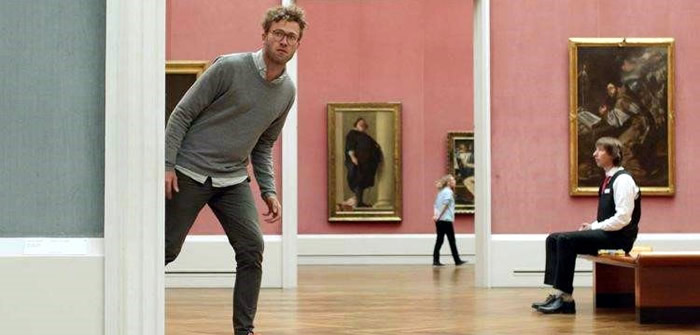I admit, it was the title, that caught my eye. Based on the shot featured in this article (the one in the art gallery), I’ve prepared myself for German communist Wes Anderson. I guess it wasn’t a mistake, since pretty much nothing can prepare you on the Self-criticism of a bourgeois dog (premiered in 2017).
The film is a comedy by young (33 years old) German director and actor Julian Radlmaier. In fact, it’s his third movie. The hero, Julian (played by Julian Radlmaier) is quite an annoying pretentious young German filmmaker. He’s annoying even for an average young intellectual. Lately, he wasn’t successful, he doesn’t have work and the only thing he does is stalking girls near galleries. What a hero. As an excuse for his inactivity, he constantly talks about doing research for his new film. Luckily enough, the apple orchard Oklahoma is just hiring, so he and his latest interest Camille can go dig into the everyday life of current proletariat. What do you know? Maybe Julian isn’t so bad (for a communist film-maker).
The first thing to say about the Self-criticism of a bourgeois dog is, that it’s full of references. From Anna Karenina to Rainer Werner Fassbinder, we get a glimpse on nearly everything today’s intellectuals waste their time on. Although the author himself said in an interview 1 that this movie is less referential that his earlier work, even the apple orchard is named after the circus in Kafka’s Amerika.
 For those, who started worrying about the amount of political jokes and cultural references, remember, that after all, the Self-criticism of a bourgeois dog is a brilliant faced-paced fresh comedy. Although I dare to say, the first half of the movie seems to be more smooth, filled with great and clever jokes. One of my personal favorites is the character called Zurab ( Zurab Rtveliasvili) – the Machiavellian and tyrannical Russian worker. Zurab isn’t communist, because he’s “strong enough for capitalism”. If you look for the perfect satire on both communist and post-communist situation in USSR/Russian Federation, search no more.
For those, who started worrying about the amount of political jokes and cultural references, remember, that after all, the Self-criticism of a bourgeois dog is a brilliant faced-paced fresh comedy. Although I dare to say, the first half of the movie seems to be more smooth, filled with great and clever jokes. One of my personal favorites is the character called Zurab ( Zurab Rtveliasvili) – the Machiavellian and tyrannical Russian worker. Zurab isn’t communist, because he’s “strong enough for capitalism”. If you look for the perfect satire on both communist and post-communist situation in USSR/Russian Federation, search no more.
The film also manages to reflect the modern trend on European art schools and its influence on the “hipster clan” and yet somehow make fun of it. At first, I was startled by the 4:3 definition and bright red opening credits (just a reflex you develop in an ex-communist country), but the quirky yet witty portrayal of the young “elite” that can be felt even from the editing just gets you.
Perhaps, it’s because Julian Radlmaier is not at all this pretentious self-centered snob like his Julian (and other artists depicted in his movie). Either way, the Self-criticism of a bourgeois dog is a movie worth seeing, no matter if you’re interested in European film, young filmmakers or you just want to see the face of your friends when you tell them the title.

